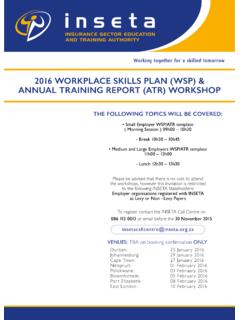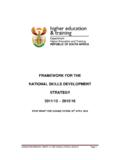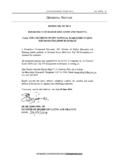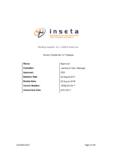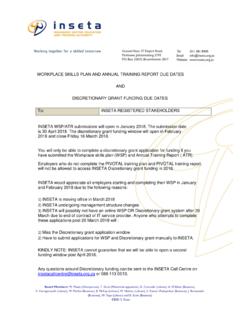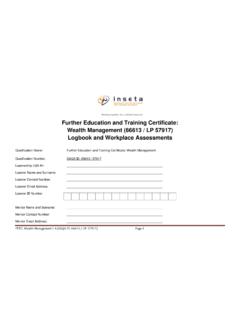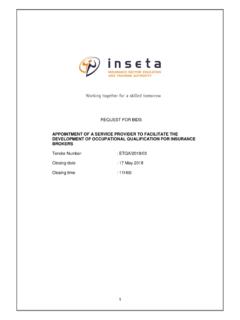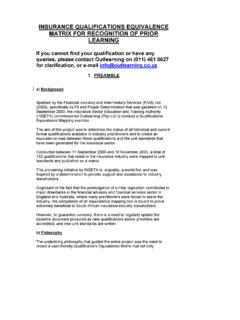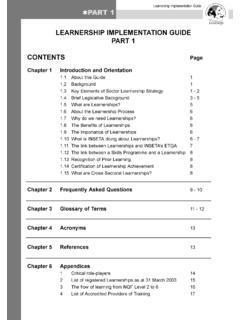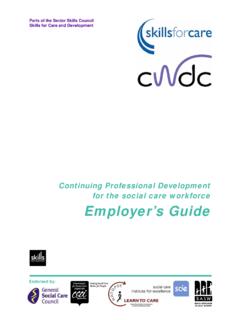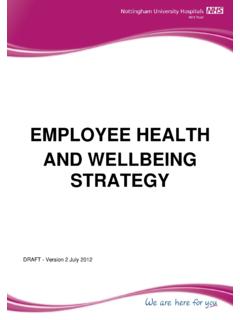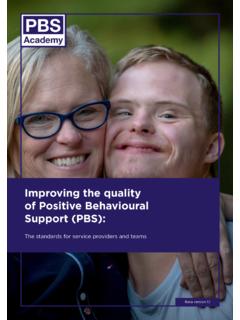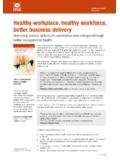Transcription of National Certificate in Insurance Administration - …
1 Working together for a skilled tomorrow . National Certificate in Insurance Administration NQF Level 2. Unit Standard 9356: Recognize the effects of HIV / AIDS. in the Insurance industry and workplace, and indicate the precautions that are necessary to avoid unnecessary transmission of the HI Virus. Credits: 4. Notional Hours of Learning: 40. Learner Material This outcomes-based learning material was developed by IISA. with funding from INSETA in March 2003. The material is generic in nature. It's purpose is to serve as a guide for the further development and customization of company-specific, learner-specific and situation-specific learning interventions.
2 18/06/03. Page 2. Contents Topic Page Unit Standard ..3. Learner material ..7. Introduction and Resources ..7. Process/Activities ..9. CCFO Matrix ..13. Examples: Guide for Assessment of Portfolio ..14. Oral assessment ..18. Additional Notes/Resources ..19. 18/06/03. Page 3. 1. TITLE: Recognise the effects of HIV/AIDS in the Insurance industry and workplace, and indicate the precautions that are necessary to avoid unnecessary transmission of the HI Virus. 2. UNIT STANDARD NO: 9356. 3. LEVEL: 2. 4. CREDITS: 4. 5. FIELD: Business Commerce and Management Studies SUB FIELD: Finance, Economics and Accounting 6.
3 ISSUE DATE. 7. REVIEW. 8. PURPOSE. This unit standard provides a broad introduction to HIV/AIDS in the workplace and the Insurance sector. It introduces some theoretical addresses a broad base of knowledge about HIV/AIDS that will enable learners to be informed and caring workers in the industry. It is a building block for Insurance related issues around the HIV/AIDS pandemic. The focus is knowledge, skills, values and attitudes in relation to the learner's own context and experience of the world of work. The qualifying learner is capable of: Understanding the effects of HIV/AIDS on the immune system.
4 Knowing how HIV/AIDS is transmitted. Knowing what behaviour is safe and what behaviour carries the risk of HIV/AIDS transmission. Knowing how to offer care and support to people with HIV/AIDS. Knowing the rights and responsibilities of employees with HIV/AIDS and those who have not yet contracted the virus. Deciding on a personal code of behaviour appropriate for own HIV/AIDS status. Knowing and understand the effects of HIV/AIDS on the economy and the Insurance industry. 9. LEARNING ASSUMED TO BE IN PLACE: There is open access to this unit standard. Learners should Hold a GETC or equivalent qualification.
5 Or Be competent in communication and mathematical literacy NQF level 1. 10 SPECIFIC OUTCOMES AND ASSESSMENT CRITERIA. SO Description Assessment Criteria 1. Know and understand The terms HIV and AIDS are known and explained at a basic HIV/AIDS and its effects on level of understanding. the human immune system The way in which the immune system works is explained with reference to the role of antibodies in the immune system. An indication is given as to how the HI Virus attacks the immune system. The concept of a window period is explained with reference to the Elisa test.
6 18/06/03. Page 4. SO Description Assessment Criteria The concept that the Elisa Test tests for antibodies is known and an indication is given of the implications that this has in terms of the window period and the use of vaccinations. The fact that all babies born to HIV/AIDS mothers initially test positive for the HI Virus is known and reasons are given to explain why these test results change over time. The concept of Voluntary Counselling and Testing (VCT) is explained with reference to the role of the Rapid Test and confirmation by the Elisa test.
7 The effects of HIV infection are explained including the ability of infected persons to perform work and the importance of lifestyle changes to boost the immune system and prevent reinfection. The importance of pre and post test counselling is known and understood and the implications of HIV testing for an individual are discussed in terms of making a personal decision to take an AIDS test. The stages of the disease are outlined with an example of what happens at each stage from infection with HIV to full-blown AIDS and death. The chances of a person surviving with AIDS are discussed with reference to the latest views on medication and the costs of the drugs.
8 2. Know and understand how The effect of body fluids on transmission of the HI virus is HIV/Aids is transmitted outlined at a basic level of understanding. Sex is identified as the most common way in which the HI Virus is transmitted and other ways in which HIV is transmitted are listed with an indication of the conditions necessary for transmission. The ways in which mother to child transmission can occur are listed and the implications of a pregnant woman/girl child having unprotected sex are indicated for the both the mother and the unborn child. Actions that an HIV positive mother can take to lower the risk of infection to the child and prolong the onset of AIDS in herself are presented in a poster to promote wellness.
9 The dangers of drug abuse and behaviour that could result in HIV transmission are explained with suggestions for limiting transmission. Precautions used in South Africa to ensure that blood products are HIV free are outlined at a basic level of understanding. 3. Know what behaviour is safe The relationship between human behaviour and HIV/AIDS is and what behaviour carries the outlined at a basic level of understanding. risk of HIV transmission Ways in which the individual can avoid contracting or spreading HIV/AIDS are named with an indication of how own behaviour can reduce the risk of infection.
10 Examples of behaviour that carry a risk of contracting HIV/AIDS are named and classified according to whether they carry a high, medium or low risk. Situations that have a potential to spread HIV/AIDS in the workplace are discussed and rated in terms of high, medium and low risk. Fears and common misunderstandings about the transmission of HIV/AIDS are described in the context of the workplace. The reasons are given why certain behaviours and activities carry a low risk of infection. 18/06/03. Page 5. SO Description Assessment Criteria The role of sexually transmitted diseases (STDs) in the transmission of the HI Virus is known and understood and an indication is given of how untreated STDs greatly increase the risk of transmission.
